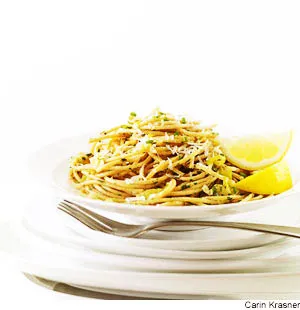Leek & Lemon Linguine
 This simple pasta recipe has bold lemony flavor. It’s nice with a salad for a light supper or serve it along with seared fish, shrimp or chicken. Vary it as you please—add a bit of crumbled goat cheese, chopped rinsed capers, shelled edamame or thin strips of yellow bell pepper.
This simple pasta recipe has bold lemony flavor. It’s nice with a salad for a light supper or serve it along with seared fish, shrimp or chicken. Vary it as you please—add a bit of crumbled goat cheese, chopped rinsed capers, shelled edamame or thin strips of yellow bell pepper.Ingredients
- 8 ounces whole-wheat linguine, or spaghetti
- 2 large lemons, plus lemon wedges for garnish
- 1 medium leek, (white and pale green parts only), thinly sliced and rinsed well
- 1 tablespoon extra-virgin olive oil
- 1/2 cup chopped flat-leaf parsley, divided
- 2 cloves garlic, crushed
- 1/4 teaspoon salt
- 1/8 teaspoon freshly ground pepper
- 3/4 cup finely grated Parmesan cheese, divided
- 1/4 cup snipped fresh chives, divided
Instructions
- Step 1
- Cook pasta in a large pot of boiling water until just tender or according to package directions. Reserve 1 1/2 cups of the cooking liquid and drain the pasta in a colander.
- Step 2
- Meanwhile, finely grate 1 tablespoon zest (see Tip) and squeeze 1/4 cup juice from the 2 lemons; set the juice aside. Pat leek slices dry. Heat oil in a large nonstick skillet over medium-high heat. Add the leek, the lemon zest, 1/4 cup parsley, garlic, salt and pepper. Cook, stirring frequently, until the leek is lightly browned and softened, about 6 minutes.
- Step 3
- Add the pasta, 1 cup of the reserved cooking liquid, the reserved lemon juice and the remaining 1/4 cup parsley to the pan. Cook, stirring constantly, until the liquid is mostly absorbed, 30 seconds to 1 minute. Add the remaining 1/2 cup liquid, if desired. Remove from the heat. Discard the garlic. Toss the pasta with 1/2 cup Parmesan and 2 tablespoons chives. Transfer to a serving bowl or bowls; sprinkle with the remaining 1/4 cup Parmesan and 2 tablespoons chives and serve with lemon wedges, if desired.
Tips
Tip: When we call for citrus zest (i.e., 1/2 teaspoon lemon zest) we are referring to the finely grated outer rind (not including the white pith) of the citrus fruit. Use a microplane grater or the smallest holes of a box grater to grate the zest. In some cases we call for long strips or threads of zest. To get long strips, peel the citrus with a vegetable peeler. To remove long threads, use a 5-hole citrus zester or remove long strips of zest with a vegetable peeler, then use a knife to cut into very thin strips.For more recipes go to EatingWell.com
No comments:
Post a Comment